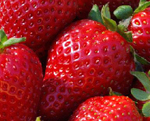Kitchen garden tips
With incessant rain, it's a good idea to keep checking your strawberries and remove any that are showing signs of rot


Redcurrants
To be sure of getting redcurrants, which are fruiting now, it’s best to grow your own, as few shops sell them. Their summer pruning is more similar to the method used for gooseberries than for blackcurrants. Prune now, to let the light in to ripen the fruit, cutting back the new growth to five leaves. (Cut again in the winter, back to a single bud to encourage the development of fruiting spears.) Redcurrants need not be grown as bushes you can fan-train them against a warm wall, which makes both pruning and picking easier. They can ripen a few weeks earlier than those in the open; the trusses are more visible, too.
Strawberries
We lost much of our strawberry harvest last year because incessant rain rotted the fruit. During wet spells, it’s most important to keep checking your strawberries and remove any showing signs of rot; otherwise, the rot will spread by touch to those around them. This year, we’ve increased the depth of straw mulch, to hold the fruit higher off the ground. If you rotate your strawberry beds every two or three years, try not to disturb the plants’ new runners; let them find and root into bare ground. Then you can dig them up and replant in late August.
Organic carrots
Dry weather in May affected the germination of our carrots this year. But it’s still worth sowing some now try an early or quick-maturing variety. You could even sow them in an empty container, as long as it has some depth. If you’ve covered your crop with fleece to protect it from the carrot-root fly, you should be able to pick out the largest carrots, as long as you replace the fleece. Where beds aren’t covered with fleece, be careful to harvest the carrots from one end in sequence, irrespective of size, to lower the incidence of pests attacking the remaining ones.
Keep ‘heritage’ seeds
Exquisite houses, the beauty of Nature, and how to get the most from your life, straight to your inbox.
Saving some vegetable seeds is worthwhile, but is particularly important when it comes to the rarer, ‘heritage’ varieties. Peas and beans are simplest; just leave a few pods unharvested and the seeds will be ready by autumn. Do make sure that all in the household know which plants are being left to set seed! You can help reduce your bills by keeping the seeds of annuals, such as lettuce, tomato and marrow. Late season brassicas, parsley and leeks should be left in the ground to flower and seed next year. Saved seed should be dried and stored in paper bags or sealed containers. If you’re saving heritage seed, be careful to grow only one variety of each type, or you risk cross-pollination and the loss of individual characteristics.
Dahlias
A dedicated cutting bed of dahlias in the kitchen garden will prevent flower-arrangers from raiding the garden borders. There are plenty of dahlias for sale at fêtes and plant fairs at this time of year if you want to restock. Water existing plants regularly in the summer. When flowering starts, keep deadheading, and you’ll have flowers until the first frosts.
Philip Maddison is head gardener at Harrington Hall, Lincolnshire (www.harringtonhallgardens.co.uk)
Country Life is unlike any other magazine: the only glossy weekly on the newsstand and the only magazine that has been guest-edited by His Majesty The King not once, but twice. It is a celebration of modern rural life and all its diverse joys and pleasures — that was first published in Queen Victoria's Diamond Jubilee year. Our eclectic mixture of witty and informative content — from the most up-to-date property news and commentary and a coveted glimpse inside some of the UK's best houses and gardens, to gardening, the arts and interior design, written by experts in their field — still cannot be found in print or online, anywhere else.
